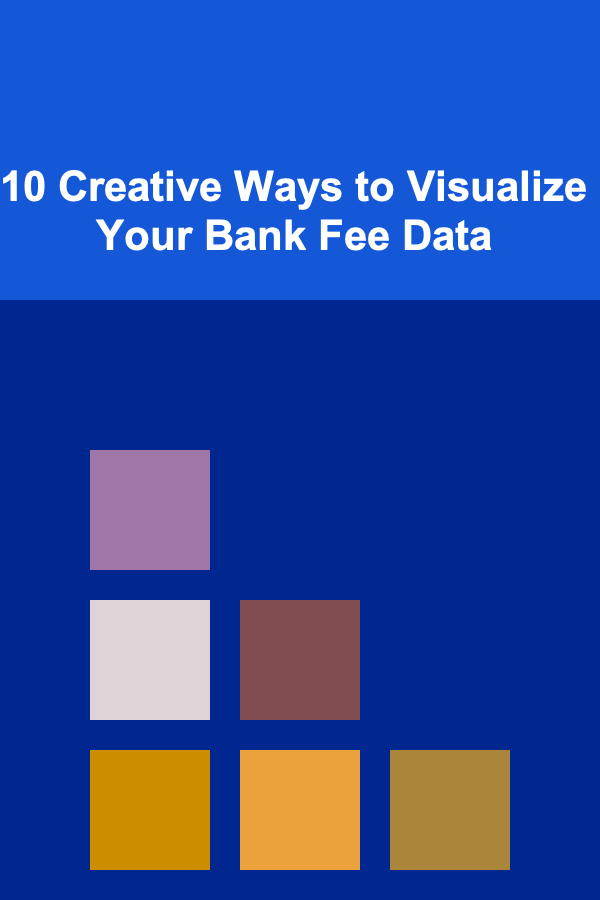
10 Creative Ways to Visualize Your Bank Fee Data
ebook include PDF & Audio bundle (Micro Guide)
$12.99$8.99
Limited Time Offer! Order within the next:

Managing bank fees is an often-overlooked yet essential part of personal and business financial planning. With the variety of fees that can accrue---ranging from monthly account maintenance charges to overdraft fees---tracking and understanding these costs can become overwhelming. This is where data visualization comes in, offering a way to transform raw numbers into actionable insights.
Effective data visualization not only helps in monitoring and understanding bank fees but also enables users to make informed decisions about how to reduce costs, optimize spending, and plan for the future. In this article, we will explore 10 creative ways to visualize your bank fee data, making it easier to track and interpret fee trends, identify areas for improvement, and ultimately gain control over your financial situation.
Stacked Bar Charts for Fee Breakdown
Purpose:
A stacked bar chart is a simple yet effective way to visualize the different types of bank fees you incur on a monthly or annual basis.
How It Works:
A stacked bar chart allows you to break down total fees into distinct categories. For example, you could categorize your bank fees into account maintenance, overdraft charges, ATM withdrawal fees, foreign transaction fees, and others. Each section of the bar represents a specific type of fee, and the overall length of the bar shows the total cost.
Benefits:
- Clarity: Quickly see where your bank fees are coming from and how each category contributes to the overall total.
- Comparative Analysis: Compare fees across different time periods (e.g., monthly or quarterly) to spot trends.
- Easy Identification: Identify categories that are consistently high and may need further investigation or action.
Example:
Imagine your stacked bar chart for the past year, where each bar represents a month, and the sections within each bar show the individual contributions of maintenance fees, ATM withdrawal fees, and others. By visually comparing each section's size, you can instantly see which type of fee is the largest.
Heatmaps for Fee Frequency
Purpose:
A heatmap is an excellent tool for visualizing the frequency of specific bank fees over time. It can highlight periods when fees are most commonly incurred, making it easier to spot patterns.
How It Works:
A heatmap uses color gradients to show the intensity of fee occurrences. For example, you can plot a grid where the x-axis represents months, and the y-axis represents different types of fees. The cells are color-coded, with darker colors indicating higher frequency or amount.
Benefits:
- Pattern Recognition: Quickly identify the months or periods when specific fees are most frequently applied.
- Spotting Costly Periods: See when your account is most susceptible to incurring fees, helping you adjust your behavior or banking habits accordingly.
Example:
If you notice a recurring dark red block on the heatmap in the summer months, this may indicate that you are being charged more often for ATM withdrawals while traveling. Recognizing this pattern can lead you to plan around it, such as choosing ATMs within your network or withdrawing larger sums less frequently.
Line Graphs for Fee Trends Over Time
Purpose:
Line graphs are a classic tool for visualizing trends over time. In the context of bank fees, a line graph can show how your fees have increased or decreased over a specific period.
How It Works:
Plot your bank fees on the y-axis and time (e.g., months or years) on the x-axis. This creates a visual representation of fee fluctuations, helping you spot periods of significant increases or decreases.
Benefits:
- Trend Analysis: Easily identify upward or downward trends in your bank fees.
- Forecasting: Anticipate future fees based on historical data.
- Cause and Effect: If there is a sharp increase in fees, you can investigate the cause, whether it's a change in bank policy or a new fee structure.
Example:
Plotting your total bank fees over the past five years may reveal a gradual increase in maintenance fees, despite no significant changes in your account usage. This could indicate that the bank is increasing fees regularly, prompting you to review other banking options.
Pie Charts for Fee Proportions
Purpose:
Pie charts are great for understanding the proportion of different types of bank fees relative to each other.
How It Works:
Each slice of the pie represents a different category of bank fee, and the size of the slice is proportional to the amount spent on that category. For instance, you might want to see what percentage of your total fees is spent on account maintenance versus ATM withdrawal fees.
Benefits:
- Simple Visual Comparison: A quick and easy way to see which fee category takes up the most of your budget.
- Immediate Insight: See which categories are the most significant and may warrant attention.
Example:
A pie chart could show that a large portion (50%) of your bank fees comes from foreign transaction charges, with a smaller portion coming from ATM withdrawals. This could signal that you need to consider alternatives, such as a bank with fewer foreign transaction fees or better international options.
Scatter Plots for Fee Distribution
Purpose:
A scatter plot is useful when you want to see how your bank fees are distributed across various factors such as account balances, transaction volumes, or specific time periods.
How It Works:
Each point on a scatter plot represents a single instance of a bank fee. The x-axis could represent your account balance at the time the fee was charged, and the y-axis could represent the fee amount. This visualization helps you see if there's a correlation between your account balance and the frequency or size of the fees.
Benefits:
- Correlation Detection: Spot trends or patterns that link certain account behaviors to fees, such as lower account balances leading to more overdraft charges.
- Outlier Identification: Identify unusual instances where the fee is abnormally high or low, which might prompt further investigation.
Example:
A scatter plot could show that higher overdraft fees are charged when your account balance falls below a certain threshold, indicating a pattern of fees associated with insufficient funds.
Bubble Charts for Fee Comparison
Purpose:
Bubble charts are an excellent way to compare multiple variables, such as different types of fees, account balances, and transaction frequency.
How It Works:
Each bubble in the chart represents an individual fee occurrence. The x-axis and y-axis could represent different factors (such as the fee type and the time it was incurred), and the size of the bubble could reflect the amount of the fee.
Benefits:
- Multivariable Insights: Visualize multiple aspects of your bank fees at once, making it easier to understand complex relationships.
- Cluster Identification: See which types of fees cluster together and could be avoided by changing account behavior.
Example:
A bubble chart could show various types of fees (maintenance, overdraft, etc.) over a year. The size of the bubbles could represent how much each fee cost, helping you pinpoint which fees have the largest financial impact.
Tree Maps for Hierarchical Fee Breakdown
Purpose:
A tree map is a useful way to show hierarchical relationships between different categories of bank fees, allowing you to explore nested structures.
How It Works:
In a tree map, each block represents a specific fee category or subcategory, with the size of the block proportional to the amount of money spent. For example, you could break down your total fees by bank service (e.g., account maintenance) and then further break it down into subcategories (e.g., overdraft fees, service charges).
Benefits:
- Detailed Breakdown: Provides an in-depth view of the breakdown of fees at multiple levels.
- Comparison Across Categories: Allows you to compare fees across categories and subcategories, helping you understand where the largest costs are.
Example:
A tree map could show that most of your fees come from monthly maintenance charges, but within that category, overdraft charges represent the largest proportion. This could lead you to consider whether you need to adjust your spending habits to avoid these charges.
Funnel Charts for Fee Reduction Goals
Purpose:
A funnel chart is ideal for visualizing your progress toward reducing bank fees over time, especially if you have set specific goals for cutting fees.
How It Works:
Each stage of the funnel represents a step in the fee reduction process. For example, you might start by identifying the fees you want to reduce, then take action by adjusting your account behavior, and finally, track the reduction in fees over several months.
Benefits:
- Progress Tracking: See how much progress you've made in reducing your fees.
- Goal-Oriented: Provides a clear visual representation of where you are in your journey toward fee reduction.
Example:
If your goal is to reduce monthly maintenance fees, the funnel chart could track your progress from identifying the high-fee areas, to switching accounts, to finally seeing a drop in monthly fees over a set period.
Area Charts for Cumulative Fees
Purpose:
An area chart can show the cumulative total of your bank fees over time, allowing you to track how fees accumulate throughout a given period.
How It Works:
The x-axis represents time (such as months), and the y-axis represents the cumulative total of fees. The area under the curve shows the total fees for each time period, allowing you to see both individual month-over-month changes and the overall trend.
Benefits:
- Total Fee Visualization: Helps you understand how much you've spent in total on bank fees and track cumulative costs over time.
- Trends and Peaks: Highlights specific periods when fees spiked, which can indicate the need for closer scrutiny.
Example:
The area chart could show that your cumulative bank fees in the first quarter of the year were minimal, but they spiked in the second quarter due to multiple overdrafts or ATM withdrawal fees, helping you pinpoint when your fees became problematic.
Radar Charts for Fee Comparison Across Accounts
Purpose:
A radar chart is useful when you have multiple bank accounts and want to compare the fee structure for each account across several categories.
How It Works:
Each axis of the radar chart represents a different category of fee (e.g., maintenance, ATM withdrawals, overdraft). Each account is plotted as a series of points along these axes, creating a web-like pattern that allows for direct comparisons.
Benefits:
- Cross-Account Comparison: Compare multiple accounts at once and see which one has the highest or most balanced fee structure.
- Holistic View: Visualize the fee differences across multiple banks or account types, helping you make decisions about which account is most cost-effective.
Example:
A radar chart could compare fees for your checking, savings, and business accounts across categories like maintenance, overdraft charges, and ATM withdrawals. This comparison would help you decide if it's worth consolidating accounts or if certain accounts are costing you more than necessary.
Conclusion
Effective data visualization can turn the complex and often opaque world of bank fees into something much more manageable and understandable. By using creative techniques such as stacked bar charts, heatmaps, and bubble charts, you can gain deep insights into your bank fee structure, identify areas for improvement, and take steps to optimize your finances. Whether you're an individual looking to reduce personal bank fees or a business aiming to cut operational costs, these visualizations can serve as powerful tools in making smarter financial decisions. The key is to embrace the right tools for the job and use the insights you gain to take control of your financial future.
Reading More From Our Other Websites
- [Personal Financial Planning 101] How to Save Money for a Down Payment on a House
- [Simple Life Tip 101] How to Simplify Holiday Decorating with Natural Materials Only
- [Home Lighting 101] How to Install Smart Lighting for a Modern Home
- [Home Soundproofing 101] How to Apply Acoustic Caulk and Sealant to Seal Sound Leaks in Your Home
- [Home Staging 101] How to Tackle Common Staging Challenges
- [Home Cleaning 101] How to Deep Clean Your Refrigerator Without the Stress
- [Soap Making Tip 101] Battling Soap Dullness: Remedies for Gray & Off-Color Bars
- [Organization Tip 101] Essential Tasks to Include in Your Monthly Home Maintenance Checklist
- [Home Party Planning 101] How to Plan a Backyard Movie Night for Families and Friends
- [Digital Decluttering Tip 101] The Minimalist's Guide to a Zero-Inbox Workflow

How to Create a Checklist for Installing Energy-Efficient Features
Read More
How to Create an Efficient Laundry Room Organization System
Read More
How to Make the Most of Your Closet with Adjustable Shelving
Read More
How to Use Neutral Decor to Attract More Buyers
Read More
How to Date After a Breakup Successfully
Read More
How to Use Social Media for Market Research: A Deep Dive
Read MoreOther Products

How to Create a Checklist for Installing Energy-Efficient Features
Read More
How to Create an Efficient Laundry Room Organization System
Read More
How to Make the Most of Your Closet with Adjustable Shelving
Read More
How to Use Neutral Decor to Attract More Buyers
Read More
How to Date After a Breakup Successfully
Read More